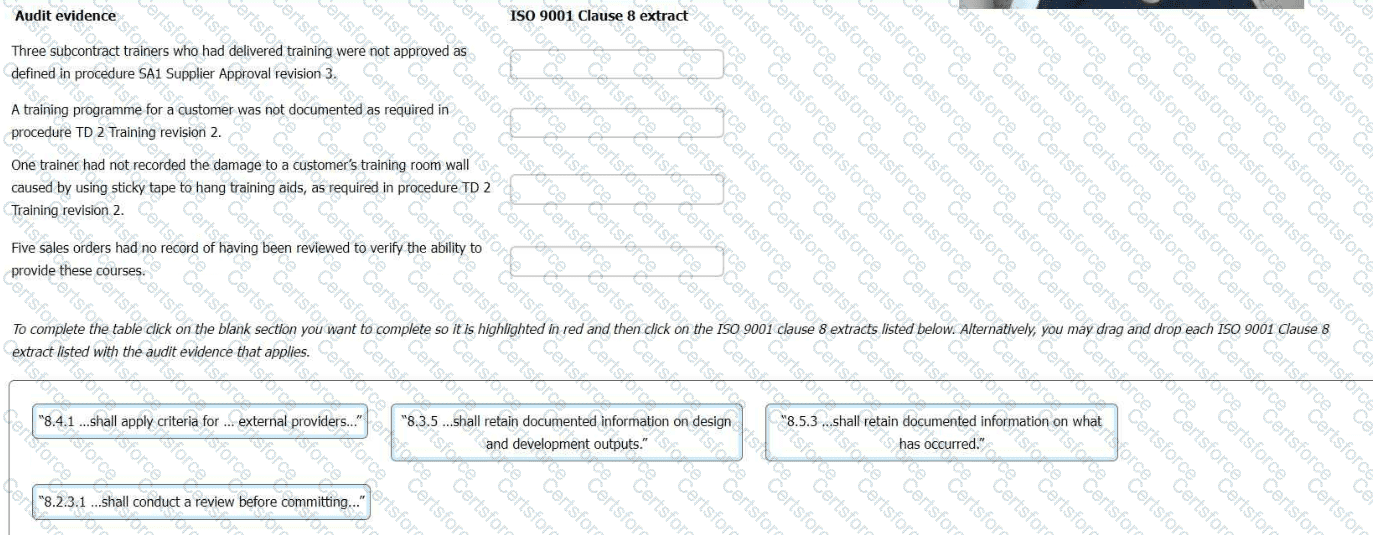You are conducting an audit at an organisation seeking certification to ISO 9001 for the first time. The organisation offers health and safety training to customers. Training courses are offered either as open courses, delivered at a public venue, or online, or as courses that are tailored to meet specific requirements. The business operates from a single office and those who deliver the training are either full-time employees or subcontractors.
You have gathered audit evidence as outlined below. Match the ISO 9001 Clause 8 extract to the audit evidence.

Which two of the following should be included in an audit plan?
Read the following role descriptions. Select two roles that are not directly involved in the audit process.
A person who provides specific knowledge or expertise to the audit team during the audit is known as a/an:
You are conducting a Stage 1 audit at an organisation that services refrigeration equipment for a large customer base.
The scope of certification is "Provision of refrigeration equipment maintenance and repair services". You are interviewing
the Managing Director to learn more about the organisation and to explore how the requirements for policy, objectives,
and risks and opportunities in ISO 9001 are addressed.
The Managing Director explains that they only use sub-contract refrigeration engineers and do not have any full-time
refrigeration engineers, which helps to optimise overhead costs. The full-time staff employed are essentially a small team
of office staff who process customer enquiries, schedule jobs and process invoices.
The Managing Director adds that the ISO 9001 requirements for competence of personnel extends to both sub-contract
and full-time staff. He also states that the full-time staff are aware of the Quality Policy, objectives and plans to address
risk and opportunities.
You ask if the sub-contract engineers have been informed of the Quality Policy, objectives and plans to address risks and
opportunities, to which the Managing Director replies that this is not applicable as they only use sub-contractors who
operate ISO 9001 certificated quality management systems. The documented information provided to the auditor
confirms this.
Which clause in ISO 9001 is most likely not to have been fulfilled in this instance?
What should the auditor document during the Stage 1 audit?
You have been nominated audit team leader of a third-party audit. Which of the following could be the two most relevant objectives of this audit?
You work for organisation A. You are asked to lead an internal audit of A's quality management system. It has a head office in Plant A1 and a second Plant A2 nearby. Due to the COVID-19 pandemic, production in A2 was discontinued and it was rented to a logistics organisation B, not related to A. There are no A employees working in A2. Organisation A expects to reassume production in A2 as soon as possible.
Which of the following actions would you consider appropriate when planning the internal audit of A's quality management system?
Will the auditee be subject to an audit follow-up if a minor nonconformity has been reported by the audit team leader in the audit conclusions?
You, as auditor, are in dialogue with the quality lead and managing director of a small business that supplies specialist
laboratory equipment and furniture.
You: "I'd like to look at how you manage change in the organisation. What changes have you made as a business, say,
over the last 12 months?"
Auditee: "We have made some strategic changes, the main one being that we no longer manufacture our own products
in house."
You: "That sounds like quite a significant change. What has been the impact of that?"
Auditee: "We now mainly sell other manufacturers' products, under their brand names, and have outsourced
manufacture of our own brand products to one of our suppliers. Unfortunately, we had to make six members of our staff
redundant. This represents about 20% of our workforce, so this has been quite a challenging time."
This scenario presents a number of audit trails to different ISO 9001 requirements.
Which three of the following requirements would be relevant audit trails for this scenario?